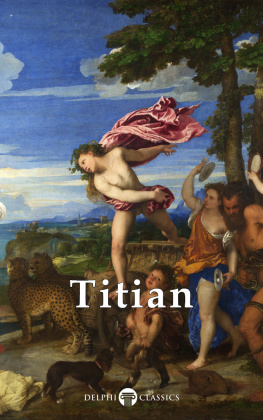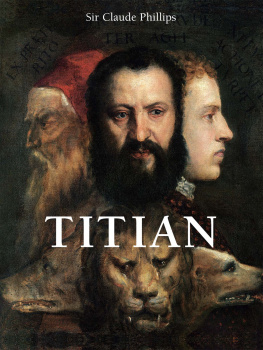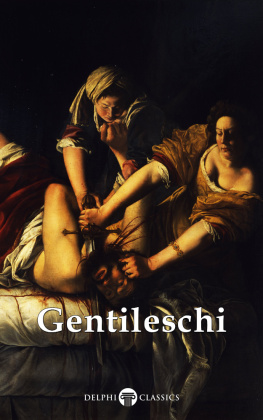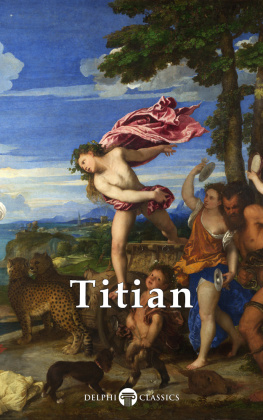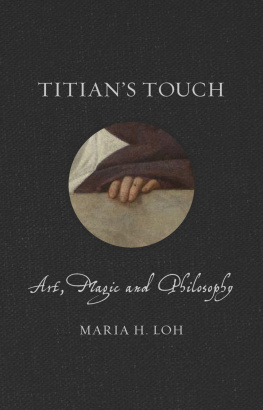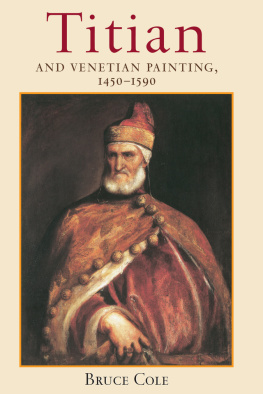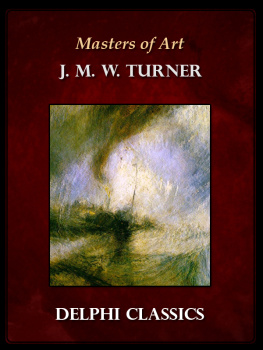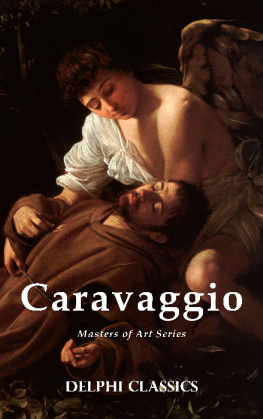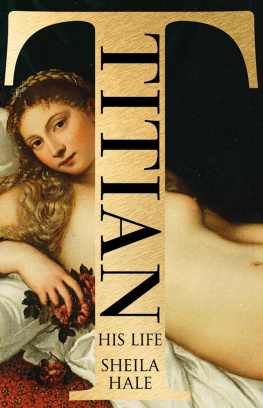

Titian
(c. 1488-1576)

Contents

Delphi Classics 2015
Version 1

Masters of Art Series
Tiziano Vecelli

By Delphi Classics, 2015
COPYRIGHT
Masters of Art - Titian
First published in the United Kingdom in 2015 by Delphi Classics.
Delphi Classics, 2015.
All rights reserved. No part of this publication may be reproduced, stored in a retrieval system, or transmitted, in any form or by any means, without the prior permission in writing of the publisher, nor be otherwise circulated in any form other than that in which it is published.
Delphi Classics
is an imprint of
Delphi Publishing Ltd
Hastings, East Sussex
United Kingdom
Contact: sales@delphiclassics.com
www.delphiclassics.com
The Highlights

Titian was born in Pieve di Cadore, near Belluno, Republic of Venice.

Titians reputed birthplace in Pieve di Cadore
THE HIGHLIGHTS

In this section, a sample of Titians most celebrated works is provided, with concise introductions, special detail reproductions and additional biographical images.
A MAN WITH A QUILTED SLEEVE

Titian was the son of Gregorio Vecelli, the superintendent of Pieve di Cadores castle, and his wife Lucia. The artists father managed local mines for their owners and was also a distinguished councillor and soldier. Many of Titians relatives, including his well-known grandfather, were notaries and the family of four were well-established in an area ruled by the undisputed might of Venice.
At the approximate age of twelve, Titian and his brother Francesco were sent to an uncle in Venice to seek an apprenticeship with a painter. The minor painter Sebastian Zuccato, whose sons became well-known mosaicists, and who was likely a family friend, arranged for the brothers to enter the studio of the elderly Gentile Bellini, from which they later transferred to that of his brother Giovanni Bellini. At that time the Bellini brothers were the leading artists of Venice and Titian enjoyed working among a group of similar minded young men his own age, including Giovanni Palma da Serinalta, Lorenzo Lotto, Sebastiano Luciani and Giorgio da Castelfranco, who would later become famous as the artist Giorgione.
A Man with a Quilted Sleeve is one of the artists earliest surviving works, painted c. 1509 and described by Giorgio Vasari in 1568 as a portrait of the celebrated poet Ludovico Ariosto, though this is now believed to be incorrect, with the true identity of the sitter being assigned to Gerolamo Barbarigo, a thirty-year-old nobleman, whose numerous political and literary contacts would have helped launch the career of the aspiring young artist.
Held in Londons National Gallery, the portrait contains the letters T. V. on the parapet on which the sitter is leaning, confirming Titians initials, although they are similar in appearance to the mysterious V. V. in several works attributed to Giorgione, such as the Giustiniani Portrait or The Gentleman with a Book .
The portrait was part of Alfonso Lpezs collection and possibly also belonged to van Dyck at one point, after which it passed to an art dealer in Amsterdam in 1639. It was famous in the seventeenth century and served as a major influence to Rembrandt, whose 1634 self-portrait similarly presents a bold male, leaning on a ledge, allowing his rich and ornate clothing to take a prominent place in the portrait. Titians painting was probably purchased by Charles I, as a portrait of Ariosto was listed in a catalogue of his goods in 1644. It was in the collection of Lord Darnley at Cobham Hall by 1824 and in 1904 it was sold to Sir George Donaldson, who, after some negotiation, agreed to sell the piece to the National Gallery for the same price he had paid for it.


Detail

Detail

Detail

Rembrandts 1634 Self-Portrait, influenced by Titians great early work
PASTORAL CONCERT

Titian joined Giorgione as an assistant and it is believed their relationship involved a significant amount of rivalry. Distinguishing between their works at this period remains a subject of scholarly controversy and there has been a substantial movement of attributions from Giorgione to Titian in the twentieth century, with few alterations adjusted the other way. For example, one of the earliest known works of Titian , Christ Carrying the Cross in the Scuola Grande di San Rocco, depicting the Ecce Homo scene was regarded as the work of Giorgione for a long period of time.
The two young masters were soon recognised as leaders of a new school of arte moderna , characterised by paintings that were more flexible and original, freed from symmetry and the remnants of hieratic conventions found in the works of the older Venetian Giovanni Bellini. The 1509 canvas, The Pastoral Concert , is a fine example of this style of painting and it has been assigned by some critics to Titian and by others to Giorgione, though most modern critics assign it to the former, due to the robustness of the figures, typical of Titians style. It has been argued that Giorgione, whose works feature musical elements and pastoral idleness, began the work, and then, after his untimely death in 1510, the canvas was completed by Titian.
The painting presents three young people on a lawn, playing together, while next to them a woman pours water from a marble basin. Both the women are naked, aside from two light vests; the two men are dressed in contemporary costumes. In the wide background is a shepherd and, among the vegetation, a far landscape. The painting may provide an allegory of poetry and music: the two women would be an imaginary apparition representing the ideal beauty, stemming from the two mens ideal. The woman with the glass vase would be the muse of tragic poetry, while the other would represent pastoral poetry. Of the two playing men, the one with the lute would represent the exalted lyric poetry, the other being an ordinary lyricist, according to the distinction made by Aristotle in his Poetics . Another interpretation would suggest that the painting is an evocation of the four elements of the natural world (water, fire, earth and air) and their harmonic relationship.
Next page
